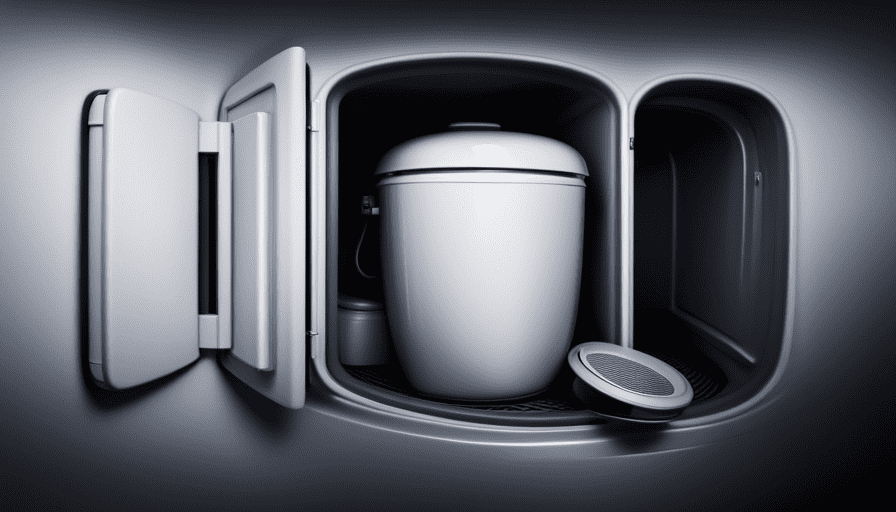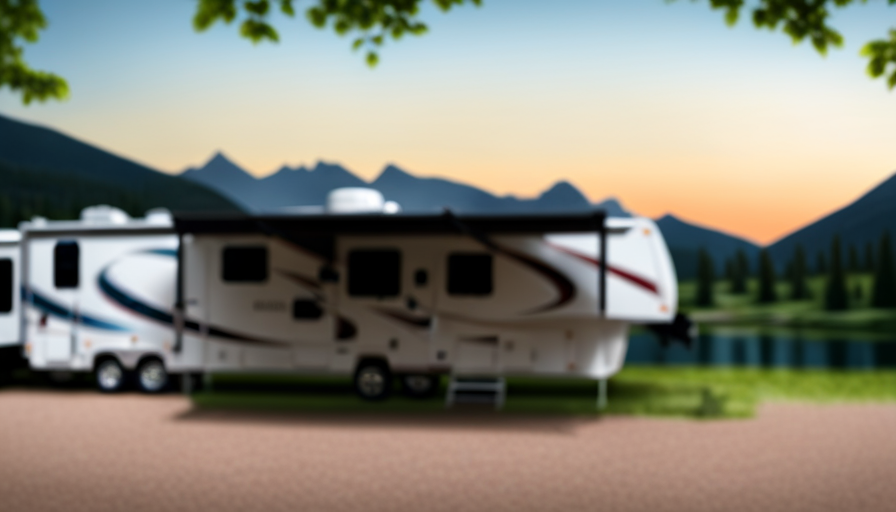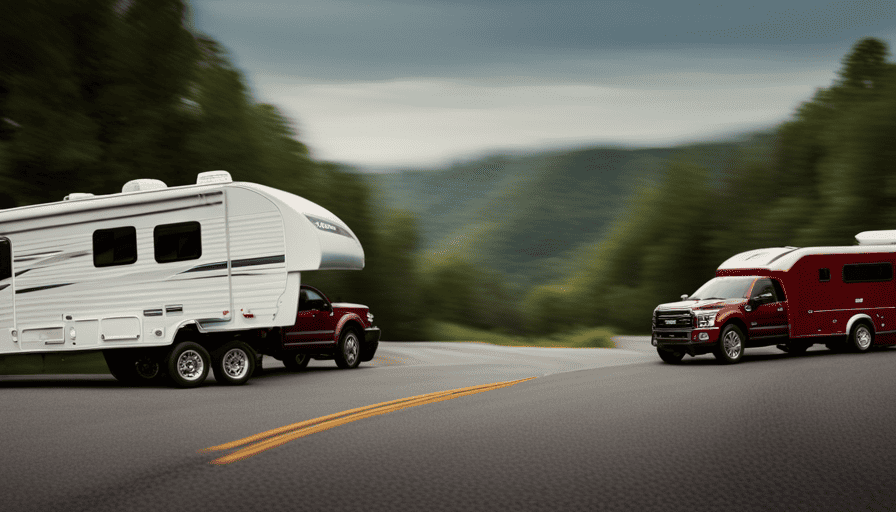Are you tired of feeling like you’re on a rollercoaster when you’re trying to sleep while camping? Look no further! We have the perfect solution for all your leveling issues.
In this article, we will reveal the best way to level a camper, and trust us, it’s a game-changer! Leveling your camper is crucial for a comfortable and safe camping experience. Imagine waking up in the morning and not having to worry about sliding out of bed or your coffee cup spilling all over the place. It’s like having your own personal oasis on wheels! One of the best ways to level a camper is by using leveling blocks or ramps. These are easy to use and can be adjusted to the perfect height to ensure your camper is stable and level. Additionally, leveling your camper properly is also important for preventing any potential damage to the camper’s suspension and shocks. Knowing how to prevent camper shocks will ultimately improve the longevity and performance of your camper for all your future adventures.
We will explore a variety of leveling techniques and tools, from traditional leveling blocks to high-tech leveling apps. Whether you’re a DIY enthusiast or prefer the convenience of automatic leveling systems, we’ve got you covered.
But leveling is not just a one-time fix. We will also share some tips on how to maintain a level camper, ensuring a smooth and enjoyable camping trip every time.
So, buckle up and get ready to discover the best way to level your camper. You’ll never have to sleep on a slope again!
Key Takeaways
- Leveling a camper is important for comfort and safety.
- Traditional leveling blocks and stabilizer jacks are popular methods for leveling a camper.
- DIY leveling techniques using wooden blocks or adjustable leveling ramps are cost-effective options.
- Hydraulic and electric leveling systems offer convenience and precise leveling, with each having their own advantages and drawbacks.
Importance of Leveling a Camper
Leveling your camper is crucial because it ensures that all the appliances, like the refrigerator and stove, function properly and prevents any potential damage to the interior of the camper. Regular maintenance is essential to keep your camper in optimal condition, and leveling plays a significant role in this.
When a camper is not level, it puts unnecessary strain on the appliances, causing them to work harder and possibly malfunction. Additionally, a camper that is not level can lead to water pooling in certain areas, potentially causing damage to the flooring or walls.
There are several benefits to having a level camper. Firstly, it ensures that your refrigerator operates efficiently, allowing your food to stay fresh and preventing spoilage. Secondly, a level camper ensures that your stove burns evenly and cooks your meals properly. It also helps to prevent any potential leaks in your plumbing system, ensuring that water flows correctly and preventing any damage. Lastly, a level camper provides a more comfortable living environment, as it prevents that feeling of being on a slant and eliminates any potential tripping hazards.
To achieve a level camper, one popular method is using traditional leveling blocks. These blocks are placed under the wheels of the camper to raise or lower it until it is level.
Traditional Leveling Blocks
Using traditional leveling blocks gives campers the opportunity to easily and securely stabilize their vehicles. These blocks, typically made of durable plastic, can be stacked and arranged to create a stable foundation for the camper.
One of the most common methods is leveling with wooden planks. By placing the blocks or planks under the tires or stabilizer jacks, campers can adjust the height of their vehicle to ensure it’s level. This is especially important when parked on uneven or sloped terrain, as an unlevel camper can cause discomfort and potentially damage appliances and furniture inside.
Using a stabilizer jack in conjunction with leveling blocks can provide additional stability. Stabilizer jacks are typically located on the corners of the camper and can be manually adjusted to provide extra support. By extending these jacks to the ground, campers can further stabilize their vehicle and minimize any rocking or swaying.
Transitioning into the subsequent section about using a bubble level, campers can also use this tool to ensure their vehicle is level. This small, handheld device contains a liquid-filled tube with a bubble, which moves to indicate whether the camper is level or not. By placing the bubble level on a flat surface inside the camper, such as a countertop or table, campers can easily determine if adjustments need to be made to achieve a level position.
Using a Bubble Level
Transitioning into the next section, campers can also rely on a trusty bubble level to ensure their vehicle is sitting nice and even. Using a bubble level is one of the most popular and effective leveling techniques, as it provides an accurate visual indication of how level the camper is.
Here are two key ways to use a bubble level for leveling your camper:
-
Start by placing the bubble level on a flat surface inside your camper, such as a countertop or table. This will give you an initial reference point to work with.
-
Adjust the camper’s leveling equipment, such as the leveling jacks or blocks, until the bubble in the level is centered. This indicates that the camper is perfectly level.
-
Another method is to attach the bubble level directly to the camper’s exterior. This allows you to check the level from the outside while making adjustments.
-
Use the leveling equipment to raise or lower the appropriate side of the camper until the bubble is centered in the level.
Using a bubble level is a straightforward and reliable way to ensure your camper is level and stable. However, if you prefer to explore DIY leveling techniques, there are plenty of creative options to consider.
DIY Leveling Techniques
To ensure your camper is stable and level, there are numerous creative DIY techniques you can explore. You can use wooden blocks or adjustable leveling ramps. Did you know that 65% of campers prefer to use DIY leveling techniques instead of relying on traditional methods? These camper leveling hacks are not only cost-effective but also allow you to level your camper using household items.
One popular method is using wooden blocks. Simply place the blocks under the tires that need to be raised and drive the camper onto them until it’s level.
Another option is using adjustable leveling ramps. These ramps can be set to the desired height and placed under the tires. They are compact, lightweight, and easy to use.
In addition to these techniques, you can also use other household items like bricks, cinder blocks, or even leveling wedges made from cut-up pieces of 2×4. These items can be easily sourced and provide a stable foundation for your camper. When using these DIY methods, it’s important to take your time and make small adjustments until you achieve the desired level.
Transitioning into the subsequent section about hydraulic leveling systems, it’s important to note that while DIY leveling techniques can be effective, they do require some manual effort. If you’re looking for a more convenient option, hydraulic leveling systems provide an automated solution for leveling your camper.
Hydraulic Leveling Systems
If you’re in search of a hassle-free solution for stabilizing and balancing your camper, look no further than hydraulic leveling systems. These systems offer a convenient and efficient way to level your camper, providing a smooth and stable experience for you and your fellow campers. Here are four reasons why hydraulic leveling systems are the way to go:
-
Ease of use: Hydraulic leveling systems are incredibly easy to operate. With just the push of a button, you can quickly and effortlessly level your camper, saving you time and effort.
-
Precise leveling: Unlike mechanical leveling systems, hydraulic systems offer precise leveling capabilities. This means that you can achieve the perfect level every time, ensuring a comfortable and safe camping experience.
-
Stability: Hydraulic leveling systems provide exceptional stability, minimizing the risk of your camper tipping or shifting during uneven terrain or windy conditions. This ensures your safety and peace of mind while enjoying the great outdoors.
-
Durability: Hydraulic leveling systems are built to last. With their sturdy construction and high-quality materials, these systems can withstand the rigors of camping and provide reliable leveling for years to come.
While hydraulic leveling systems offer numerous benefits, it’s important to consider the potential downsides as well. These systems can be more expensive and require regular maintenance to keep them in top shape. However, the convenience and stability they provide often outweigh these drawbacks.
Transitioning to the next section about electric leveling systems, we can explore another hassle-free option for leveling your camper.
Electric Leveling Systems
Experience the convenience and peace of mind that comes with effortless leveling using electric leveling systems. When it comes to leveling a camper, electric leveling systems offer several advantages over hydraulic systems.
One of the main benefits is the ease of use. With electric leveling systems, all it takes is a push of a button to automatically level your camper. Gone are the days of manually cranking and adjusting hydraulic jacks.
Electric systems also tend to be more compact and lightweight, making them easier to install and transport.
In terms of pros and cons, electric leveling systems have their own set. One advantage is their precision. These systems allow for more accurate leveling, ensuring that your camper is perfectly balanced. Electric systems also tend to be quieter and require less maintenance compared to their hydraulic counterparts.
However, one drawback of electric leveling systems is that they rely on electrical power, so you need to have a reliable power source or backup option. Additionally, they may have a higher initial cost compared to hydraulic systems.
As we transition into the next section about automatic leveling systems, it is important to note that electric leveling systems are one type of automatic leveling system. Stay tuned to learn more about the various options available for effortless leveling of your camper.
Automatic Leveling Systems
One potential concern about automatic leveling systems is the cost, but there are affordable options available for every budget.
When it comes to automatic leveling systems, there are two main types to consider: hydraulic and electric. Both have their pros and cons.
Hydraulic leveling systems are known for their strength and durability. They can handle heavier loads and are generally more reliable. However, they can be more expensive and require regular maintenance.
On the other hand, electric leveling systems are more affordable and easier to install. They’re also quieter and require less maintenance. However, they may not be as powerful as hydraulic systems and may struggle with heavier loads.
Another option to consider is air bag leveling systems. These systems use air bags to level the camper and provide a smooth ride. They’re known for their ability to adjust to uneven terrain and provide stability. However, they can be more expensive and may require more maintenance than other systems.
Transitioning into the next section about air bag leveling systems, it’s important to consider all the options before making a decision.
Air Bag Leveling Systems
Consider using air bag leveling systems for your camper to ensure stability and a smooth ride, as they’re known for their ability to adjust to uneven terrain. Air bag leveling systems, also known as air suspension, use air-filled bags to level the camper. Here are four reasons why air bag leveling systems are a great option for leveling your camper:
-
Easy installation: Air bag leveling systems can be easily installed on most campers. They require minimal modifications and can be done by a DIY enthusiast or a professional.
-
Adjustable height: These systems allow you to adjust the height of your camper based on the terrain. Whether you’re parked on a slope or on uneven ground, you can easily level your camper with the touch of a button.
-
Smooth ride: Air bag leveling systems provide a smoother ride by reducing the impact of bumps and vibrations. This not only improves comfort during travel but also protects your camper from unnecessary wear and tear.
-
Integrated leveling jacks: Some air bag leveling systems come with integrated leveling jacks, which further enhance the stability of your camper. These jacks provide additional support and prevent swaying or rocking when parked.
When it comes to leveling your camper, air bag leveling systems offer convenience, stability, and a smooth ride. However, if you prefer a more high-tech approach, the next section will cover leveling apps and tools for your camper.
Leveling Apps and Tools
Enhance your camping adventure with the latest leveling apps and tools for your camper. When it comes to leveling challenges, having the right accessories can make all the difference.
There are several leveling apps available that use your smartphone’s built-in sensors to help you determine the level of your camper. These apps provide a visual representation of the camper’s position, making it easy to adjust the leveling jacks as necessary.
Additionally, there are leveling tools designed specifically for campers, such as bubble levels and leveling blocks. Bubble levels can be mounted on the camper’s exterior or interior, providing a quick and easy way to check if your camper is level. Leveling blocks are stackable and can be placed under the camper’s tires to raise or lower one side, ensuring a level setup.
By utilizing these leveling apps and tools, you can easily overcome leveling challenges and ensure a comfortable camping experience.
As we move into the next section, let’s explore some helpful tips for maintaining a level camper.
Tips for Maintaining a Level Camper
For a stress-free camping experience, it’s crucial to keep your camper on an even keel. Here are some camper leveling hacks and tips for maintaining a level camper: One of the first steps to ensuring a level camper is to use leveling blocks or ramps to raise the low side of the camper. It’s also important to make sure the tires are properly chocked to prevent movement. Additionally, utilizing a bubble level can help you accurately determine if your camper is level. And for better camper antenna reception tips, make sure to extend and position the antenna properly to get the best signal.
-
Regularly inspect your leveling jacks: Check for any signs of damage or wear and tear. Make sure they’re properly lubricated and functioning correctly. If you notice any issues, address them immediately to prevent further damage.
-
Use leveling blocks: These handy tools can be placed under your camper’s wheels to even out any uneven terrain. They’re lightweight, easy to use, and can be adjusted to the desired height. Make sure to choose durable, high-quality blocks that can withstand the weight of your camper.
-
Invest in a leveling app: While we discussed leveling apps in a previous subtopic, it’s worth mentioning again. These apps use your phone’s accelerometer to help you determine if your camper is level. They’re convenient and can save you a lot of time and effort.
-
Check for water leaks: Water leaks can cause your camper to become unlevel. Make sure to regularly inspect the roof, windows, and doors for any signs of leaks. If you find any, fix them immediately to prevent further damage.
By following these camper leveling hacks and maintaining your leveling jacks, you can ensure a smooth and enjoyable camping experience without any worries about an uneven camper.
Frequently Asked Questions
Can I use regular wooden blocks or do I need to invest in specific leveling blocks for my camper?
Regular wooden blocks can work as a temporary solution for leveling a camper, but investing in specific leveling blocks is a more practical choice.
Let me share an anecdote to illustrate why. My friend used wooden blocks under his camper, but they quickly deteriorated due to exposure to weather and moisture.
In contrast, leveling blocks designed for campers are made of durable materials that can withstand the elements and provide a stable base. Avoid the hassle and go for the specialized blocks.
Are there any alternative methods to using a bubble level for leveling a camper?
When it comes to leveling a camper without a bubble level, there are a few alternative methods you can try.
One option is to use a smartphone app that has a built-in leveling feature. These apps use the phone’s accelerometer to determine if the surface is level.
Another method is to use a water level, which involves filling a clear tube with water and using it to gauge the levelness of the camper.
Both of these methods can be effective and convenient alternatives to using a bubble level.
How do hydraulic leveling systems work and are they suitable for all types of campers?
Hydraulic leveling systems are a game-changer when it comes to leveling campers. They use hydraulic jacks to adjust the camper’s height, ensuring a perfectly level surface. Plus, they can be operated with just the push of a button. The best part? You can level your camper without even needing a bubble level! It’s a convenient and efficient solution for all types of campers.
Are electric leveling systems difficult to install and are they worth the investment?
Electric leveling systems can be a convenient and efficient option for leveling a camper. They’re generally easy to install and operate, making them a popular choice for many campers. However, there are pros and cons to consider.
Electric leveling systems offer the convenience of automated leveling, saving time and effort. On the downside, they can be more expensive than manual systems and may require electrical power.
Ultimately, the decision to invest in an electric leveling system depends on individual preferences and budget.
What are the advantages and disadvantages of using air bag leveling systems for campers?
Advantages of using air bag leveling systems for campers include improved stability and levelness, as well as the ability to adjust the height of the camper for uneven terrain. Air bag systems can also provide a smoother ride, reducing the impact of bumps and vibrations.
However, there are some disadvantages to consider. They can be more expensive compared to other leveling methods and may require regular maintenance. Additionally, air bag systems may not be suitable for all campers, depending on their weight and size.
Can Greywater in a Camper Affect the Leveling Process?
When it comes to the leveling process of a camper, it’s important to consider the impact of greywater. Greywater in a camper explained: this refers to the wastewater generated from sinks, showers, and laundry. If not properly managed, greywater can affect the leveling process by adding unnecessary weight and potentially causing imbalance. Therefore, it’s crucial to discharge greywater appropriately to maintain a smooth and safe camping experience.
Conclusion
In conclusion, leveling a camper is not just a mundane task, but a crucial step in ensuring a smooth and comfortable camping experience. As we embark on our adventures, let’s remember the importance of balance and stability, just like in life. Whether you choose traditional leveling blocks, hydraulic systems, or the convenience of automatic leveling, the goal remains the same – to create a sturdy foundation where memories can be made.
So let’s level up and embrace the journey with confidence, knowing that our camper is safely grounded in the beauty of the great outdoors.










